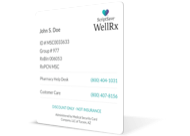Copyright 2024
Medical Security Card Company, LLC
All Rights Reserved
WellRx will never sell your personal information. Period. By signing up I agree to WellRx's terms of use and privacy policy.
By Opeyemi Ibrahim, PharmD Candidate 2021,
University of Colorado Skaggs School of Pharmacy
November 17, 2020
Osteoarthritis (OA) is the most common form of arthritis, affecting over 32.5 million US adults.1 It is a long-lasting condition that happens when the tissues in the joint (where two bones come together) break down. Normally, the ends of the two bones are covered with a protective tissue called cartilage, but with OA the cartilage breaks down and the two bones rub against each other. This is why it is also called “wear and tear” arthritis. Over time the bones change, which can lead to pain, stiffness and swelling. Sometimes, this can limit a patient’s ability to perform their day to day activities.1
Osteoarthritis affects people differently and although it can occur at any age, it mostly affects older adults. It can develop in any joint but most frequently appears in the hands, hips, knees, lower back and neck.2
Symptoms of osteoarthritis develop gradually and worsen over time.3
If you have any symptoms listed above, contact your provider. They will review your symptoms, perform lab tests (joint fluid analysis), do a physical examination and imaging tests (X-ray/MRI) to help diagnose if you have OA.1
While there is no cure for OA, there are a variety of therapies that can relieve symptoms that people may have.1
Physical Activity: It is encouraged to get at least 150 minutes of moderate to vigorous exercise per week. Movement is very important in the treatment of pain and stiffness. Physical activity should include strengthening exercises that help build muscles around those painful joints to help reduce the stress on them. Range of motion exercises, stretching, aerobic exercise and balance exercise should also be included.2
Weight loss: If overweight, weight loss can slow down joint damage. Research shows that every pound of weight loss removes four pounds of pressure on lower body joints.2
Medicines: There are pain and anti-inflammatory medications (available in pill form, syrup, patch, cream and injectable) that can be used to manage symptoms.2
Assistive devices: Crutches and canes can be used if movement becomes difficult.2
Surgery: This is a last resort option. Your doctor may recommend joint replacement surgery to help relieve pain and improve mobility if all other treatment options fail.2
If you think you have OA, make an appointment with your doctor as soon as possible. The sooner you can receive a diagnosis and get treatment, the quicker you can improve the quality of your life.
References:

For your convenience, use the ScriptSave® WellRx mobile app. Now savings are well in hand, right at the pharmacy counter. Save on your family's prescription medicines.
Learn More
Your choice. Get a ScriptSave WellRx Savings Card. Or Download the free mobile app from the App Store or Google Play Store
Get A Card
ScriptSave WellRx Grocery Guidance leverages leading-edge nutritional data science to help you know which food products on your grocery store shelf are truly good for YOU.
Healthy Foods For YouTags:

June 09, 2022

April 26, 2022
You need to log into the site to use this feature
This feature requires registration. Sign up or log in to your free WellRx account to gain access to this and other tools to help make managing your medications and wellness easier.
Benefits Include:
 Store & manage your medication list
Store & manage your medication list
 Medication pricing updates
Medication pricing updates
 Medication information
Medication information
 Pill & refill reminders
Pill & refill reminders
 Medication journal & mood log
Medication journal & mood log
This feature requires registration. Sign up or log in to your free WellRx account to gain access to this and other tools to help make managing your medications and wellness easier.
Benefits Include:
 Store & manage your medication list
Store & manage your medication list
 Medication pricing updates
Medication pricing updates
 Medication information
Medication information
 Pill & refill reminders
Pill & refill reminders
 Medication journal & mood log
Medication journal & mood log
You will be redirected to your program in 5 seconds.
Our Terms and Conditions and Privacy Policy have recently been updated.
By declining you will be logged out of your account